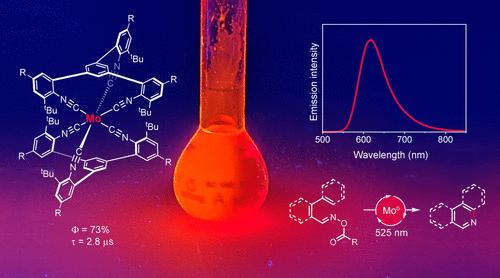使Mo(0)成为Ir(III)在荧光粉和光催化剂中的竞争替代品
IF 15.6
1区 化学
Q1 CHEMISTRY, MULTIDISCIPLINARY
引用次数: 0
摘要
铱用于商业发光装置和光催化,但它是最稀有的稳定化学元素之一。因此,用丰富的金属取代光活性分子配合物中的铱(III)具有很大的兴趣。第一排过渡金属通常倾向于产生较差的发光行为,并且仍然难以获得具有超过贵金属基光催化剂的氧化还原性质的激发态。在这里,我们用一种非贵重的第二排过渡金属克服了这些挑战。为钼(0)量身定制的配位球导致可与铱(III)配合物相媲美的光致发光量子产率,并且铱(III)通常无法实现的光化学还原反应成为可能。这些发展为用地球上丰富的金属取代照明应用中的贵金属和推进金属基光催化突破现有限制开辟了新的前景。本文章由计算机程序翻译,如有差异,请以英文原文为准。

Making Mo(0) a Competitive Alternative to Ir(III) in Phosphors and Photocatalysts
Iridium is used in commercial light-emitting devices and in photocatalysis but is among the rarest stable chemical elements. Therefore, replacing iridium(III) in photoactive molecular complexes with abundant metals is of great interest. First-row transition metals generally tend to yield poorer luminescence behavior, and it remains difficult to obtain excited states with redox properties that exceed those of noble-metal-based photocatalysts. Here, we overcome these challenges with a nonprecious second-row transition metal. Tailored coordination spheres for molybdenum(0) lead to photoluminescence quantum yields that rival those of iridium(III) complexes and photochemical reduction reactions not normally achievable with iridium(III) become possible. These developments open new perspectives for replacing noble metals in lighting applications with Earth-abundant metals and for advancing metal-based photocatalysis beyond current limits.
求助全文
通过发布文献求助,成功后即可免费获取论文全文。
去求助
来源期刊
CiteScore
24.40
自引率
6.00%
发文量
2398
审稿时长
1.6 months
期刊介绍:
The flagship journal of the American Chemical Society, known as the Journal of the American Chemical Society (JACS), has been a prestigious publication since its establishment in 1879. It holds a preeminent position in the field of chemistry and related interdisciplinary sciences. JACS is committed to disseminating cutting-edge research papers, covering a wide range of topics, and encompasses approximately 19,000 pages of Articles, Communications, and Perspectives annually. With a weekly publication frequency, JACS plays a vital role in advancing the field of chemistry by providing essential research.

 求助内容:
求助内容: 应助结果提醒方式:
应助结果提醒方式:


